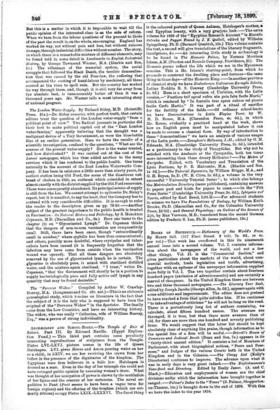ARCHZOLOGY AND Scaoos-Boors.—The Temple of Deir el Bahari. Part III.
By Edouard Neville. (Egypt Explora- tion Fund.) — This third part contains some peculiarly interesting reproductions of sculptures from the Temple. Plates LW.-LXVI. picture scenes in the life of Queen Hatshepsu. LVI. gives Horus and Amon pouring water on her as a child; in LXIV. we see her receiving the crown from her father in the presence of the dignitaries of the kingdom. The Egyptians were firm believers in a Salic law. Hatshepsu is dressed as a man. Even in the day of her triumph she could not have outraged public opinion by assuming woman's dress. W hat was thought of her usurpation of power is shown by the mutilation of her figure and the erasure of her cartoucne. The naval ex- pedition to Punt (Punt seems to have been a vague term for foreign regions) and the offering of the trophies (which are evi- dently African) occupy Plates LEIX.-LVX XVI. The finest thing is the coloured portrait of Queen AAIIMAS, Hatshepsn's mother, a real Egyptian beauty, with a vary gracious look.—The extra volume for 1899 of the "Egyptian *search Account" is Hieratic Ostraka and Papyri Found by .T. E. Quitell, edited by Wilhelm Spiegelberg, Ph.D. (Bernard Quaritch, 10s.) This volume contains the text, a second will give translations of the literary fragments, inscriptions, &c.—An interesting little study in archteology is to be found in The Homeric Palace, by Norman Morrison Isham, A.M. (Preston and Rounds Company, Providence, $1). The Homeric poems reflect the life which we see in the Mycenaean remains. This is Mr. Isham's starting-point, from which he proceeds to construct the dwelling place and fortress—the same thing in those days—of the Homeric King.—In another province of classical study we have Dialectorum Italicarum ErFinpla Selecta, Latine Reddita R. S. Conway (Cambridge University Press, 23. 6d.) Here is a short specimen, of Umbrian, with the Latin version,—" Funtlere trif apruf rufru ute peia fete Serfe Marti," which is rendered by "In fontulis tres apros rubros vel piceos facito Cerfo Martio." It was part of a ritual of sacrifice for the fertility of the fields.—Of ordinary school-books we have Demonstrations in Latin Elegiac Verse, by W. H. D. Rouse, M.A. (Clarendon Press, 4s. 6d.), in which Mr. Rouse, evidently a practised hand at the work, shows how an English poem must be manipulated before it can be made to assume a classical form. By way of introduction to these " demonstrations " we have an analysis of various usages of the Latin poets.—Xenophon's Hellenics, I.-II., edited by G. M. Edwards, M.A. (Cambridge University Press, 3s. 6(1.), intended as a preliminary to the study of Thucydides. But why not be satisfied with the Anabasis or the Cyroptedia, both ten times more interesting than these dreary Hellenics ?—The Medea of Euripides. Edited, with Vocabulary and Translation of the Lyric Portions, by P. B. Holcombe, M.A. (Blackie and Son. is 6d.)—The Tutorial Dynamics, by William Briggs, M.A., and G. H. Bryan, Sc.D. (W. B. Clive, 3s. 6d.), a volume in the very successful "University Tutorial Series "; to which also belongs the Matriculation Directory (same publishers), containing answers to papers past and hints for papers to come.—ln the "Pitt Press Series" (Cambridge University Press, 3s. ed.), Iphigenie auf Tauris, edited by Karl Breul, Litt.D.—For advanced students in science we have The Foundations of Zoology, by William Keith Brooke, Ph.D. (Macmillan and Co., for the Columbia University Press, $2.50) ; and General Physiology r an Outline of the Science of Life, by Max Verworn, M.D., translated from the second German edition by Frederic S. Lee, Ph.D. (same publishers, 16s.)






































 Previous page
Previous page